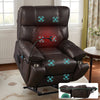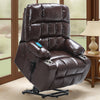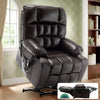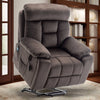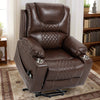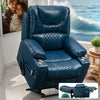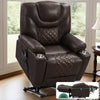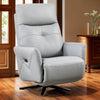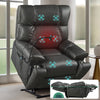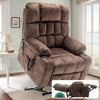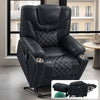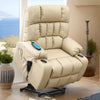Understanding Medicare Coverage
Medicare Part B Benefits
Medicare Part B plays a pivotal role in covering medical costs related to durable medical equipment (DME), which can include power lift recliners. If you qualify, Medicare Part B may cover the essential lifting mechanism part of the recliner, which is considered medical equipment. This is a significant benefit for those in need of assistance with sitting and standing due to certain medical conditions. Typically, Medicare Part B will cover up to 80% of the approved amount for the lifting device. The patient is responsible for the remaining 20% coinsurance plus any applicable deductibles. It’s important for beneficiaries to understand that coverage is contingent on the chair being deemed medically necessary and prescribed by a doctor.

The 80/20 Coinsurance Breakdown
Under Medicare Part B, an individual is responsible for 20% of the cost of the lifting mechanism in power lift recliners, while Medicare covers the remaining 80%. This is known as the 80/20 coinsurance, where Medicare assumes the bulk of the cost—a significant benefit for those needing this type of durable medical equipment. However, it's important to note that the coinsurance applies only to the lifting device's price and not to the entire cost of the chair. Therefore, beneficiaries must cover the 20% coinsurance plus any additional amounts related to the chair's full price out-of-pocket. To lessen this financial burden, it may be wise to consider additional coverage such as Medicare Supplement Insurance (Medigap) that can help with out-of-pocket costs.
Qualifying for a Medicare-Reimbursed Lift Chair
Medical Necessity Documentation
To qualify for a Medicare-reimbursed lift chair, specific medical necessity documentation is essential. This involves having a doctor's prescription that clearly states the lift chair is a medical necessity due to your condition. The prescription must outline that you have severe arthritis or other neuromuscular diseases which render you unable to get up from a regular chair without assistance. Additionally, the documentation should indicate that you can operate the chair independently and that the lift function will significantly help in improving your condition or slow its deterioration. It is vital to ensure that all paperwork is thorough and accurate to meet Medicare's strict requirements for coverage.
Approved Suppliers and Durable Medical Equipment
To qualify for a Medicare-reimbursed lift chair, it is essential to purchase from approved suppliers. Medicare has a list of approved providers that are authorized to supply Durable Medical Equipment (DME), which includes lift chairs. These suppliers must comply with Medicare's standards and billing procedures. It's crucial to ensure that your provider is enrolled in Medicare and meets strict quality and financial standards. To avoid extra costs and denial of coverage, choose an approved DME supplier and confirm that they accept assignment – meaning they agree to Medicare's approved amount for the equipment as full payment. When buying a recliner, check the supplier's credentials, and ask for a detailed breakdown of costs to understand your financial responsibility.
The Purchasing Process
Steps to Getting a Lift Chair Through Medicare
To acquire a lift chair with Medicare assistance, follow these steps:
- Consult your doctor: Have a discussion regarding your mobility issues and the necessity of a power lift recliner.
- Obtain a prescription: If deemed medically necessary, your doctor will write a prescription for the chair.
- Find a supplier: Search for a Medicare-approved supplier of durable medical equipment in your area.
- Submit paperwork: Provide the supplier with your prescription and Medicare details.
- Medicare review: The supplier submits a claim to Medicare on your behalf, which will be reviewed for approval.
- Payment: If approved, you pay the 20% coinsurance, while Medicare covers the remaining 80% of the lift mechanism's cost.
Remember, the chair’s frame and extra features are not covered. Budgeting for the coinsurance and any additional features is key to a smooth purchasing process.
Out-of-Pocket Costs to Consider
When purchasing a power lift recliner with the help of Medicare, there are several out-of-pocket expenses you'll need to plan for. Although Medicare Part B may cover up to 80% of the lifting mechanism cost, you remain responsible for the remaining 20% coinsurance. This is the portion of the cost that is not covered by Medicare and must be paid by the beneficiary. Additionally, before Medicare’s coverage kicks in, you must meet your annual Part B deductible. Beyond the coinsurance and deductible, there may be further costs for the chair's features that exceed what Medicare approves. It's also worth noting that you’ll need to buy your chair from a Medicare-approved supplier to qualify for reimbursement. This could limit your buying options and might affect the final price. Make sure to research and compare the costs from various suppliers. Remember that lift chairs available on the market have different price points, and Medicare will only cover the cost of the lift mechanism, not the entire chair. Hence, choose a chair that accommodates both your medical needs and your budget.
Different Types of Reclining Chairs Eligible for Medicare
Features of Power Lift Recliners
Medicare covers various types of power lift recliners, each with features tailored to assist individuals with limited mobility. These chairs typically come with a motorized lift mechanism that pushes the entire chair up from its base, enabling users to transition from a sitting to a standing position with ease. Often, they include multiple reclining angles for optimal comfort, adjustable back and leg rest positions, and some models even offer heating and massage options. Cushioning is designed for long-term seating, with attention to pressure relief and support to areas like the lower back and legs. Fabric choices are typically durable and easy to clean, accommodating the needs of individuals with different health conditions. It's important to note that while Medicare covers the cost of the lifting mechanism, the additional comfort features might lead to extra out-of-pocket expenses.
Limitations and Exclusions
While Medicare can support the purchase of certain types of power lift recliners, it's crucial to understand that not all features and models are covered. Medicare typically only covers the cost of the lifting mechanism in these chairs, which is considered durable medical equipment (DME). The coverage does not extend to the full cost of the furniture piece itself.
Furthermore, Medicare will not provide reimbursement for luxury features such as heat and massage functions, or for recliners made of premium materials. Also excluded are additional accessories that are not deemed medically necessary. Therefore, while you can select from a variety of eligible power lift recliners, be aware of these limitations and exclusions. You will be responsible for any costs that exceed the coverage for the basic lifting mechanism, so when shopping, it's advisable to inquire about which features are Medicare-eligible.
Additional Financial Assistance Options
Medicaid and Other State Programs
While Medicare provides substantial help with costs, there are additional financial aid options for those needing big reclining chairs. Medicaid and state-run programs can offer extra support for individuals who qualify. Medicaid, which varies by state, may cover the remaining cost after Medicare benefits are applied. State programs often have special funds or grants designated for assistive devices. To access these benefits, individuals should connect with their local Medicaid office or look into state-specific assistance programs. These programs may have varying eligibility criteria, such as income limits or medical need assessments. It's important for beneficiaries to thoroughly research and apply for these additional options to minimize out-of-pocket expenses.
Veterans Benefits and Assistive Devices
Veterans may find additional support beyond Medicare for purchasing big reclining chairs, like power lift recliners. Veterans' benefits could include access to assistive devices through the Department of Veterans Affairs (VA). If you're a veteran, you could be eligible for financial assistance or grants aimed specifically at those in need of mobility aids, including lift chairs. Programs like the Home Improvements and Structural Alterations (HISA) grant may help cover costs. Additionally, the VA also provides medical equipment, through prosthesis and sensory aids programs, to those who qualify. To access these benefits, veterans should contact their local VA office to learn about the specific programs available, apply for benefits, and understand the requirements and paperwork needed for coverage.
Maintenance and Repair Coverage
Warranty and Repair Services Under Medicare
When a Medicare beneficiary obtains a power lift recliner, it’s important to understand the coverage for warranty and repair services. Under Medicare Part B, once the 80/20 coinsurance is applied and the deductible met, maintenance and repair coverage kicks in which broadly subsidizes costs for servicing. Additionally, Medicare covers the repair or replacement of the lifting mechanism if it malfunctions, provided the equipment is under warranty. However, labor costs for repairs might not be included. Beneficiaries must ensure the chair is purchased from a Medicare-approved supplier to guarantee coverage. Documentation of both warranty details and repairs should be maintained for seamless processing of any future claims. It's recommended to consult with the supplier about extended warranty options for more comprehensive coverage.
Handling Repairs and Parts Replacement
When you're using a Medicare-approved lift chair, it's essential to understand the process for handling repairs and replacing parts. Medicare may cover repair costs for equipment that it considers 'medically necessary.' If your power lift recliner requires repairs, these are usually covered under the durable medical equipment (DME) provision of Medicare Part B, as long as the repairs are reasonable and necessary. To get these repairs done, you need to contact the supplier that provided your chair. Be aware that Medicare will only cover the costs if the supplier is enrolled in Medicare and if you have reported the issue within the warranty period.
As for parts replacement, if certain components of your lift chair malfunction or wear out, Medicare might cover the replacement parts. Keep in mind, coverage is only provided if the replacement is deemed medically necessary and the chair is not under warranty. You typically would need to pay the 20% coinsurance after Medicare pays its share for the covered repairs or replacements. Always check with your supplier about the extent of your coverage before committing to repairs or ordering replacement parts.
Frequently Asked Questions
Understanding the Approval Process
Gaining an understanding of the Medicare approval process is key to obtaining a power lift reclining chair through this program. Firstly, the individual seeking coverage must meet certain medical necessity requirements, as outlined by their healthcare provider. This involves getting a prescription indicating that the lift chair is an essential part of the patient's treatment plan due to limited mobility or other qualifying conditions. Once the prescription is obtained, the next step is to work with a Medicare-approved supplier who deals in Durable Medical Equipment (DME). The chosen equipment must be labeled as meeting Medicare's durability standards and should exclusively lift one's body using a motorized mechanism. It is crucial to submit all required documentation accurately to avoid delays in the approval process. After submission, Medicare will review the claim and determine eligibility. If approved, Medicare Part B will cover 80% of the cost related to the lifting mechanism of the chair, while the patient will be responsible for the remaining 20% coinsurance as well as any additional costs for features not covered by Medicare.
Coping with Denied Claims
If you've submitted a claim for a power lift recliner and Medicare denies it, don't despair. Begin by reviewing the denial letter carefully to understand the specific reason for the denial. It's possible that the claim was missing information or that Medicare's coverage criteria were not sufficiently demonstrated. In any case, you have the right to appeal. The appeals process involves several levels, starting with a reconsideration by a different claims reviewer. If the decision is again unfavorable, you can request a hearing before an administrative law judge. It's essential to gather all supporting documents, including medical necessity documentation from your healthcare provider, and to submit your appeal within the designated timeframe. Assistance from a Medicare counselor or patient advocate may be beneficial in navigating the appeals process.
Next Steps After Medicare Approval
Choosing the Right Power Lift Recliner
Once you receive Medicare approval, it's crucial to select the appropriate power lift recliner to meet your needs. To ensure comfort and functionality, consider these points:
- Size and Fit: Ensure that the chair dimensions suit your body size and the available space in your home.
- Recline Mechanism: Opt for an easy-to-use control that meets your mobility requirements.
- Upholstery: Choose a material that you find comfortable and that is easy to clean.
- Weight Capacity: Check the chair's maximum weight capacity to ensure it can support your weight securely.
- Additional Features: Look for any extra features such as heated seating, massage options, or storage pockets that might enhance your experience.
Remember, the right power lift recliner should not only fit into your living space neatly but should also provide you with the support and ease of use necessary for improved mobility and comfort.
Making the Most Out of Your Medicare Benefits
Once Medicare approves your lift chair claim, there are ways to maximize your benefits to ensure you get the most value out of your coverage. First, do thorough research to identify a high-quality power lift recliner that aligns with your medical needs and personal preferences. Look for chairs with additional features that might improve your comfort or mobility, such as heat or massage functions. These features may not be covered by Medicare but could offer significant benefits for your well-being.
Additionally, consider reaching out to local senior centers or medical equipment specialists who can provide insights into the best models and brands. Network with individuals who have experience with lift chairs to gain personal testimonials.
Remember to also keep meticulous records of all transactions and communications with Medicare and your supplier, ensuring any warranties or guarantees are fully understood and properly filed. This diligence will help resolve any future issues with ease, keeping your focus on your health and comfort rather than on bureaucratic hurdles. By taking these steps, you can make the most out of your Medicare benefits and secure a reclining chair that significantly enhances your daily life.








